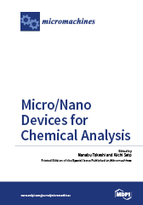Micro/Nano Devices for Chemical Analysis
A special issue of Micromachines (ISSN 2072-666X). This special issue belongs to the section "C:Chemistry".
Deadline for manuscript submissions: closed (20 March 2016) | Viewed by 139006
Special Issue Editors
Interests: microfluidic/nanofluidic devices; lab on a chip; micro total analysis systems; ultrasensitive detection
Special Issues, Collections and Topics in MDPI journals
Interests: microfluidic devices; micro total analysis systems; organ on a chip; human on a chip; cell-based assay
Special Issue Information
Dear Colleagues,
Since a concept of the micro total analysis systems has been advocated, various kinds of micro/nano devices have been developed by researchers in many fields, such as chemistry, chemical engineering, mechanical engineering, electric engineering, biology, medicine, etc. The analytical techniques for small sample volume, using the micro/nano devices, has had a large impact on the fields of biology, medicine, and biotechnology, as well as analytical chemistry. Some applications (e.g., DNA analysis, point-of-care testing (POCT), etc.) are already commercially available, and various applications will be put into practical use from now on.
In this Special Issue, we invite contributions (original research papers, review articles, and brief communications) that focus on chemical and biochemical analyses (analytical techniques) using various kinds of the micro/nano devices, including micro/nanofluidic devices, paper-based devices, digital microfluidics, biochip (DNA, protein, cell) array. We also welcome contributions related to the hyphenated devices with other conventional analytical instruments, the pretreatment devices for analysis/assay, and so on.
Prof. Dr. Manabu Tokeshi
Prof. Dr. Kiichi Sato
Guest Editors
Manuscript Submission Information
Manuscripts should be submitted online at www.mdpi.com by registering and logging in to this website. Once you are registered, click here to go to the submission form. Manuscripts can be submitted until the deadline. All submissions that pass pre-check are peer-reviewed. Accepted papers will be published continuously in the journal (as soon as accepted) and will be listed together on the special issue website. Research articles, review articles as well as short communications are invited. For planned papers, a title and short abstract (about 100 words) can be sent to the Editorial Office for announcement on this website.
Submitted manuscripts should not have been published previously, nor be under consideration for publication elsewhere (except conference proceedings papers). All manuscripts are thoroughly refereed through a single-blind peer-review process. A guide for authors and other relevant information for submission of manuscripts is available on the Instructions for Authors page. Micromachines is an international peer-reviewed open access monthly journal published by MDPI.
Please visit the Instructions for Authors page before submitting a manuscript. The Article Processing Charge (APC) for publication in this open access journal is 2600 CHF (Swiss Francs). Submitted papers should be well formatted and use good English. Authors may use MDPI's English editing service prior to publication or during author revisions.
Keywords
- chemical analysis
- micro total analysis systems
- micro/nanofluidics
- paper-based microfluidics
- digital microfludics
- biochip array
- microfluidic devices hyphenated with other conventional analytical instruments
- pretreatment devices for analysis/assay







